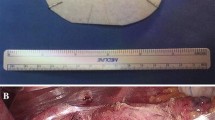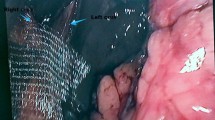Abstract
Introduction
Laparoscopic techniques have led to hiatal procedures being performed with less morbidity but higher failure rates. Biologic mesh (biomesh) has been proposed as an alternative to plastic mesh to achieve durable repairs while minimizing stricturing and erosion. This paper documents the lack of significant dysphagia after the placement of biomesh during hiatal hernia repair.
Methods
A retrospective chart review of patients who underwent paraesophageal hiatal hernia repairs with and without biomesh was performed. Hernias were diagnosed with esophagogastroscopy and esophageal manometry. Demographic, procedural, and pre- and post-surgery symptom data were recorded.
Results
Fifty-six patients underwent biomesh repair while 33 patients underwent non-mesh repairs. The procedure time for mesh repairs was significantly longer (p = 0.004). Hospital stays, resting lower esophageal sphincter pressure, and mean contraction amplitudes were similar between groups. Residual pressure was measured to be significantly higher in patients who had mesh repairs (p = 0.0001). Normal esophageal peristalsis was maintained in both groups. At first follow-up, mesh patients complained of more dysphagia and bloating, but non-mesh patients had more heartburn. At second follow-up, non-mesh patients had more symptom complaints than mesh patients.
Conclusion
The addition of biomesh for hiatal hernia repair does not result in significantly increased patient dysphagia rates postoperatively compared with patients who underwent primary repair.




Similar content being viewed by others
References
Soricelli E, Basso N, Genco A, Cipriano M. Long-term results of hiatal hernia mesh repair and antireflux laparoscopic surgery. Surg Endosc. 2009;23: 2499–504.
Granderath FA, Kamolz T, Schweiger UM, Pasiut M, Haas CF, Wykypiel H, Pointner R. Long-term results of laparoscopic antireflux surgery. Surg Endosc. 2002;16: 753–7.
Granderath FA, Carlson MA, Champion JK, Szold A, Basso N, Pointner R. Prosthetic closure of the esophageal hiatus in large hiatal hernia repair and laparoscopic antireflux surgery. Surg Endosc. 2006;20: 367–79.
Leeder PC, Smith G, Dehn TC. Laparoscopic management of large paraesophageal hiatal hernia. Surg Endosc. 2003;17: 1372–5.
Targarona EM, Novell J, Vela S, Cerdan G, Bendahan G, Torrubia S, Kobus C, Rebasa P, Balague C, Garriga J, Trias M. Mid term analysis of safety and quality of life after the laparoscopic repair of paraesophageal hiatal hernia. Surg Endosc. 2004;18: 1045–50.
Johnson JM, Carbonell AM, Carmody BJ, Jamal MK, Maher JW, Kellum JM, DeMaria EJ. Laparoscopic mesh hiatoplasty for paraesophageal hernias and fundoplications: a critical analysis of the available literature. Surg Endosc. 2006;20: 362–6
Keidar A, Szold A. Laparoscopic repair of paraesophageal hernia with selective use of mesh. Surg Laparosc Endosc Percutan Tech. 2003;13: 149–54.
Davis SS, Jr. Current controversies in paraesophageal hernia repair. Surg Clin North Am. 2008;88: 959–78, vi
Schauer PR, Ikramuddin S, McLaughlin RH, Graham TO, Slivka A, Lee KK, Schraut WH, Luketich JD. Comparison of laparoscopic versus open repair of paraesophageal hernia. Am J Surg. 1998;176: 659–65.
Hashemi M, Peters JH, DeMeester TR, Huprich JE, Quek M, Hagen JA, Crookes PF, Theisen J, DeMeester SR, Sillin LF, Bremner CG. Laparoscopic repair of large type III hiatal hernia: objective followup reveals high recurrence rate. J Am Coll Surg. 2000;190: 553–60; discussion 60–1
Diwan TS, Ujiki MB, Dunst CM, Swanstrom LL. Biomesh placement in laparoscopic repair of paraesophageal hernias. Surg Innov. 2008;15: 184–7.
Jobe BA, Aye RW, Deveney CW, Domreis JS, Hill LD. Laparoscopic management of giant type III hiatal hernia and short esophagus. Objective follow-up at three years. J Gastrointest Surg. 2002;6: 181–8; discussion 8
Khaitan L, Houston H, Sharp K, Holzman M, Richards W. Laparoscopic paraesophageal hernia repair has an acceptable recurrence rate. Am Surg. 2002;68: 546–51; discussion 51–2
Targarona EM, Bendahan G, Balague C, Garriga J, Trias M. Mesh in the hiatus: a controversial issue. Arch Surg. 2004;139: 1286–96; discussion 96
Frantzides CT, Madan AK, Carlson MA, Stavropoulos GP. A prospective, randomized trial of laparoscopic polytetrafluoroethylene (PTFE) patch repair vs simple cruroplasty for large hiatal hernia. Arch Surg. 2002;137: 649–52.
Carlson MA, Richards CG, Frantzides CT. Laparoscopic prosthetic reinforcement of hiatal herniorrhaphy. Dig Surg. 1999;16: 407–10.
Muller-Stich BP, Holzinger F, Kapp T, Klaiber C. Laparoscopic hiatal hernia repair: long-term outcome with the focus on the influence of mesh reinforcement. Surg Endosc. 2006;20: 380–4.
Coluccio G, Ponzio S, Ambu V, Tramontano R, Cuomo G. [Dislocation into the cardial lumen of a PTFE prosthesis used in the treatment of voluminous hiatal sliding hernia, A case report]. Minerva Chir. 2000;55: 341–5.
Dutta S. Prosthetic esophageal erosion after mesh hiatoplasty in a child, removed by transabdominal endogastric surgery. J Pediatr Surg. 2007;42: 252–6.
Edelman DS. Laparoscopic paraesophageal hernia repair with mesh. Surg Laparosc Endosc. 1995;5: 32–7.
Gajbhiye R, Quraishi AH, Mahajan P, Warhadpande M. Dysphagia due to transmural migration of polypropylene mesh into esophagus. Indian J Gastroenterol. 2005;24: 226–7.
Griffith PS, Valenti V, Qurashi K, Martinez-Isla A. Rejection of goretex mesh used in prosthetic cruroplasty: a case series. Int J Surg. 2008;6: 106–9.
Oelschlager BK, Barreca M, Chang L, Pellegrini CA. The use of small intestine submucosa in the repair of paraesophageal hernias: initial observations of a new technique. Am J Surg. 2003;186: 4–8.
Wisbach G, Peterson T, Thoman D. Early results of the use of acellular dermal allograft in type III paraesophageal hernia repair. Jsls. 2006;10: 184–7.
Oelschlager BK, Pellegrini CA, Hunter J, Soper N, Brunt M, Sheppard B, Jobe B, Polissar N, Mitsumori L, Nelson J, Swanstrom L. Biologic prosthesis reduces recurrence after laparoscopic paraesophageal hernia repair: a multicenter, prospective, randomized trial. Ann Surg. 2006;244: 481–90.
Lee E, Frisella MM, Matthews BD, Brunt LM. Evaluation of acellular human dermis reinforcement of the crural closure in patients with difficult hiatal hernias. Surg Endosc. 2007;21: 641–5.
Stylopoulos N, Rattner DW. The history of hiatal hernia surgery: from Bowditch to laparoscopy. Ann Surg. 2005;241: 185–93.
Yano F, El Sherif A, Filipi CJ, Mittal SK. Use of temporary esophageal stent in management of perforations after benign esophageal surgery. Surg Laparosc Endosc Percutan Tech. 2008;18: 283–5
Desai KM, Diaz S, Dorward IG, Winslow ER, La Regina MC, Halpin V, Soper NJ. Histologic results 1 year after bioprosthetic repair of paraesophageal hernia in a canine model. Surg Endosc. 2006;20: 1693–7.
Badylak S, Kokini K, Tullius B, Whitson B. Strength over time of a resorbable bioscaffold for body wall repair in a dog model. J Surg Res. 2001;99: 282–7.
Gloeckner DC, Sacks MS, Billiar KL, Bachrach N. Mechanical evaluation and design of a multilayered collagenous repair biomaterial. J Biomed Mater Res. 2000;52: 365–73.
Strange PS. Small intestinal submucosa for laparoscopic repair of large paraesophageal hiatal hernias: a preliminary report. Surg Technol Int. 2003;11: 141–3.
Poulose BK, Scholz S, Moore DE, Schmidt CR, Grogan EL, Lao OB, Nanney L, Davidson J, Holzman MD. Physiologic properties of small intestine submucosa. J Surg Res. 2005;123: 262–7.
Sandoval JA, Lou D, Engum SA, Fisher LM, Bouchard CM, Davis MM, Grosfeld JL. The whole truth: comparative analysis of diaphragmatic hernia repair using 4-ply vs 8-ply small intestinal submucosa in a growing animal model. J Pediatr Surg. 2006;41: 518–23.
Author information
Authors and Affiliations
Corresponding author
Additional information
Presented at the Society of Surgery of the Alimentary Tract, Digestive Disease Week Annual Meeting. New Orleans, LA. May 2010.
Rights and permissions
About this article
Cite this article
Goers, T.A., Cassera, M.A., Dunst, C.M. et al. Paraesophageal Hernia Repair with Biomesh Does Not Increase Postoperative Dysphagia. J Gastrointest Surg 15, 1743–1749 (2011). https://doi.org/10.1007/s11605-011-1596-5
Received:
Accepted:
Published:
Issue Date:
DOI: https://doi.org/10.1007/s11605-011-1596-5




